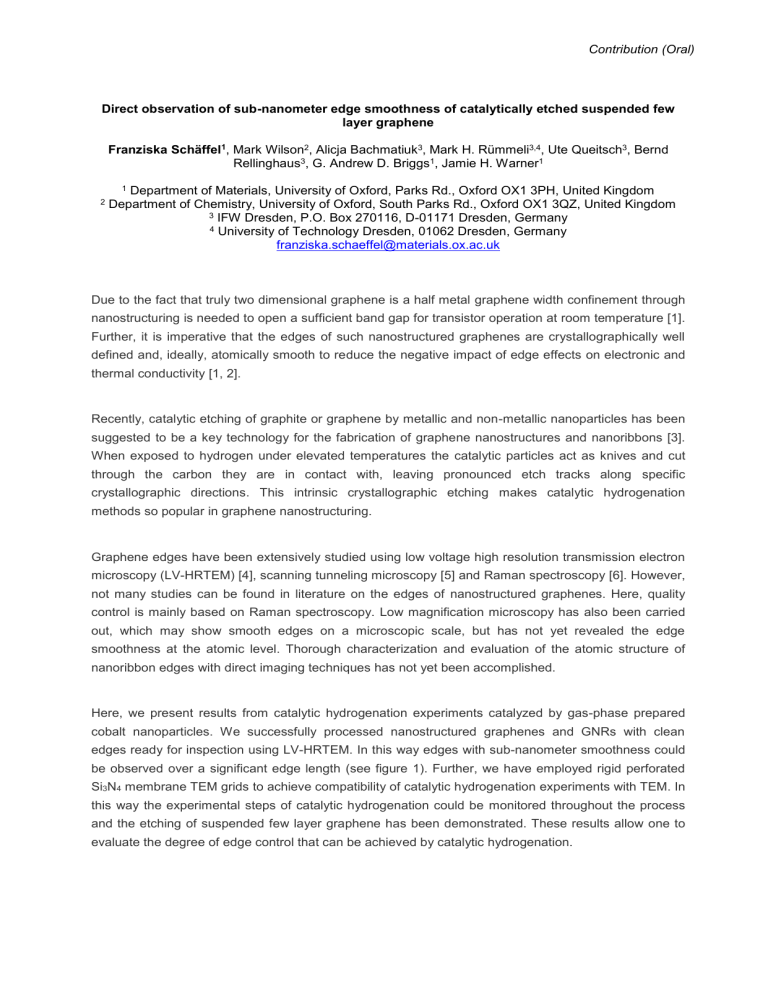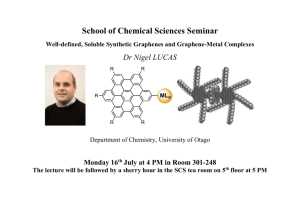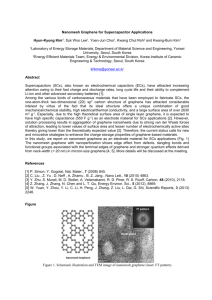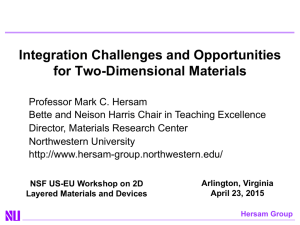1 Department of Materials, University of Oxford, Parks Rd., Oxford

Contribution (Oral)
Direct observation of sub-nanometer edge smoothness of catalytically etched suspended few layer graphene
Franziska Schäffel 1 , Mark Wilson 2 , Alicja Bachmatiuk 3 , Mark H. Rümmeli 3,4 , Ute Queitsch 3 , Bernd
Rellinghaus 3 , G. Andrew D. Briggs 1 , Jamie H. Warner 1
1 Department of Materials, University of Oxford, Parks Rd., Oxford OX1 3PH, United Kingdom
2 Department of Chemistry, University of Oxford, South Parks Rd., Oxford OX1 3QZ, United Kingdom
3 IFW Dresden, P.O. Box 270116, D-01171 Dresden, Germany
4 University of Technology Dresden, 01062 Dresden, Germany franziska.schaeffel@materials.ox.ac.uk
Due to the fact that truly two dimensional graphene is a half metal graphene width confinement through nanostructuring is needed to open a sufficient band gap for transistor operation at room temperature [1].
Further, it is imperative that the edges of such nanostructured graphenes are crystallographically well defined and, ideally, atomically smooth to reduce the negative impact of edge effects on electronic and thermal conductivity [1, 2].
Recently, catalytic etching of graphite or graphene by metallic and non-metallic nanoparticles has been suggested to be a key technology for the fabrication of graphene nanostructures and nanoribbons [3].
When exposed to hydrogen under elevated temperatures the catalytic particles act as knives and cut through the carbon they are in contact with, leaving pronounced etch tracks along specific crystallographic directions. This intrinsic crystallographic etching makes catalytic hydrogenation methods so popular in graphene nanostructuring.
Graphene edges have been extensively studied using low voltage high resolution transmission electron microscopy (LV-HRTEM) [4], scanning tunneling microscopy [5] and Raman spectroscopy [6]. However, not many studies can be found in literature on the edges of nanostructured graphenes. Here, quality control is mainly based on Raman spectroscopy. Low magnification microscopy has also been carried out, which may show smooth edges on a microscopic scale, but has not yet revealed the edge smoothness at the atomic level. Thorough characterization and evaluation of the atomic structure of nanoribbon edges with direct imaging techniques has not yet been accomplished.
Here, we present results from catalytic hydrogenation experiments catalyzed by gas-phase prepared cobalt nanoparticles. We successfully processed nanostructured graphenes and GNRs with clean edges ready for inspection using LV-HRTEM. In this way edges with sub-nanometer smoothness could be observed over a significant edge length (see figure 1). Further, we have employed rigid perforated
Si
3
N
4
membrane TEM grids to achieve compatibility of catalytic hydrogenation experiments with TEM. In this way the experimental steps of catalytic hydrogenation could be monitored throughout the process and the etching of suspended few layer graphene has been demonstrated. These results allow one to evaluate the degree of edge control that can be achieved by catalytic hydrogenation.
Contribution (Oral)
References
[1] X. Wang, Y. Ouyang, X. Li, H. Wang, J. Guo, H. Dai, Phys. Rev. Lett. 100 (2008) 206803.
[2] A. A. Balandin, S. Ghosh, W. Bao, I. Calizo, D. Teweldebrhan, F. Miao, C. N. Lau, Nano Lett. 8
(2008) 902.
[3] L. Ci, Z. Xu, L. Wang, W. Gao, F. Ding, K. F. Kelly, B. I. Yakobson, P. M. Ajayan, Nano Res. 1 (2008)
116; S. S. Datta, D. R. Strachan, S. M. Khamis, A. T. C. Johnson, Nano Lett. 8 (2008) 1912; F. Schäffel,
J. H. Warner, A. Bachmatiuk, B. Rellinghaus, B. Büchner, L. Schultz, M. H. Rümmeli, Nano Res. 2
(2009) 695; L. Gao, W. Ren, B. Liu, Z.-S. Wu, C. Jiang, H.-M. Cheng, J. Am. Chem. Soc. 131 (2009)
13934.
[4] Ç. Ö. Girit, J. C. Meyer, R. Erni, M. D. Rossell, C. Kisielowski, L. Yang, C.-H. Park, M. F. Crommie,
M. L. Cohen, S. G. Louie, A. Zettl, Science 323 (2009) 1705; Z. Liu, K. Suenaga, P. J. F. Harris, S.
Iijima, Phys. Rev. Lett. 102 (2009) 015501.
[5] Y. Kobayashi, K.-I. Fukui, T. Enoki, K. Kusakabe, Phys. Rev. B 73 (2006) 125415; K. A. Ritter, J. W.
Lyding, Nat. Materials 8 (2009) 235.
[6] C. Casiraghi, A. Hartschuh, H. Qian, S. Piscanec, C. Georgi, A. Fasoli, K. S. Novoselov, D. M.
Basko, A. C. Ferrari, Nano Lett. 9 (2009) 1433; A. K. Gupta, T. J. Russin, H. R. Gutiérrez, P. C. Eklund,
ACS Nano 3 (2009) 45.
Figures
Figure1: a) LV-HRTEM micrograph of a sub-nanometer smooth edge of suspended catalytically etched few layer graphene; b) The same image as in a – here, the scale bar and the measurement marker from roughness determination have been included; c) Fast Fourier transformation of the area marked orange in b. The yellow lines represent armchair (ac) directions, the red line represents a zigzag (zz) direction of the graphene crystal lattice.
From this the etching direction has been determined to be along a zigzag direction.







